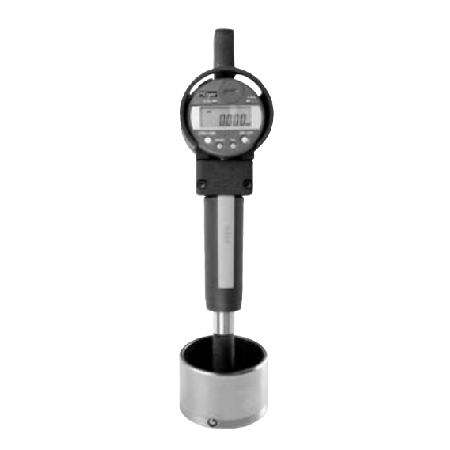
Dyer’s experience and superior gage designs result in better bore gaging
Dyer is a technical leader in bore gages. We have a large selection of proven gage designs to choose from when we are evaluating a bore measuring application. Many of our new designs make bore measuring a “Hands off” process.
Advances in gage technology and electronics have brought significant improvements to the bore measuring process. Dyer’s non-tipping two point contact bore gages assure parts manufacturers that the accuracy and repeatability of a measurement does not depend on the skill of the operator. These “hands off” gages guarantee that every measurement taken is correct and Gage R & R capable.
Eliminating Operator Error A look at the operation of a nontipping gage will show the instrument’s advantages. The gaging process is quick and easy. The operator inserts the gage and takes a reading without having to do any rocking or aligning. Operator influence is a problem of the past.
Superior Design and Construction Here are real reasons Dyer’s bore gages are the industry’s best performers.
indicator. This results in the best linear accuracy.
≤ ± 0.000040″ (≤ ± 0.001 mm)
The correct self-centering base for each measuring range assures axial and radial alignment in each bore every time it measures.
Heat Stabilization. The handles (measuring transfer shafts) of all Dyer precision bore gages are made from Invar steel, a special alloyed steel that resists temperature change. This eliminates errors due to circulating temperatures.
GAGE REPEATABILITY AND REPRODUCIBILITY REPORT
Gage I.D.: General Gage R & R Comments: Mastered @ 25.40mm No. Trials: 2
Spec. Limits: 25.375 / 25.426 Characteristic: Main Bore ID No. Operatiors: 3 No. Parts: 10
| Operator A | Operator B | Operator C | |||||||||||||||
| 1 Trial | 2 Trial | Range | 1 Trial | 2 Trial | Range | 1 Trial | 2 Trial | Range | |||||||||
| 1 | 25.386 | 25.385 | 0.001 | 1 | 25.386 | 25.385 | 0.001 | 1 | 25.384 | 25.385 | 0.001 | ||||||
| 2 | 25.384 | 25.384 | 0.000 | 2 | 25.384 | 25.384 | 0.000 | 2 | 25.383 | 25.383 | 0.000 | ||||||
| 3 | 25.382 | 25.382 | 0.000 | 3 | 25.382 | 25.381 | 0.000 | 3 | 25.381 | 25.381 | 0.000 | ||||||
| 4 | 25.383 | 25.383 | 0.000 | 4 | 25.383 | 25.382 | 0.001 | 4 | 25.382 | 25.382 | 0.000 | ||||||
| 5 | 25.382 | 25.382 | 0.000 | 5 | 25.352 | 25.381 | 0.001 | 5 | 25.381 | 25.381 | 0.000 | ||||||
| 6 | 25.382 | 25.380 | 0.002* | 6 | 25.381 | 25.380 | 0.001 | 6 | 25.381 | 25.381 | 0.000 | ||||||
| 7 | 25.382 | 25.382 | 0.000 | 7 | 25.383 | 25.381 | 0.002* | 7 | 25.382 | 25.381 | 0.001 | ||||||
| 8 | 25.384 | 25.384 | 0.000 | 8 | 25.385 | 25.384 | 0.001 | 8 | 25.385 | 25.384 | 0.001 | ||||||
| 9 | 25.384 | 25.384 | 0.000 | 9 | 25.383 | 25.383 | 0.000 | 9 | 25.383 | 25.383 | 0.000 | ||||||
| 10 | 25.382 | 25.381 | 0.001 | 10 | 25.381 | 25.380 | 0.001 | 10 | 25.381 | 25.381 | 0.000 | ||||||
| Totals | 253.831 | 253.827 | 0.004 | Totals | 253.830 | 253.821 | 0.009 | Totals | 253.823 | 253.822 | 0.003 | ||||||
| Sum
507.658 |
Xbar A
25.3829 |
Rbar A
0.004 |
Sum
507.651 |
Xbar B
25.3826 |
Rbar B
0.009 |
Sum
507.645 |
Xbar C 25.3823 | Rbar C
0.0003 |
|||||||||
| Rp: 0.0043 TV: 0.0076 | R: 0.0005
UCL-R: 0.0017 |
Max X: 25.3829 * Limit of individual R’s. Correct Rbar by repeating those readings using Min X: 25.3823 the same appraiser and unit or discard the values and reaverage and X Diff: 0.0007 recompute R-bar and the value UCL-R. | |
| Measurement Unit Analysis: | Process Variation Analysis: | Tolerance Analysis: TOL = 0.0510 | |
| Equipment Variation (E.V.) E.V. = 0.0024 | % Equipment Variation (E.V.)
% E.V. = 31.94% |
% Equipment Variation (E.V.)
% E.V. = 4.77% |
|
| Appraiser Varation (A.V.) A.V. = 0.0017 | % Appraiser Variation (A. V.)
% e. v. = 31.94% |
% Appraiser Variation (A.V.)
% A.V. = 3.27% |
|
| Repeatbility & Reproductbility R & R = 0.0029 | % Repeatability & Reproducibility
% R & R = 38.73% |
% Repeatability & Reproducibility
% R & R = 5.78% |
|
| Process Variation (P.V.) P.V. = 0.0070 | % Process Variation (P.V.)
% P.V. = 92.19% |
% Process Variation (P.V.)
% P.V. = 13.76% |
|